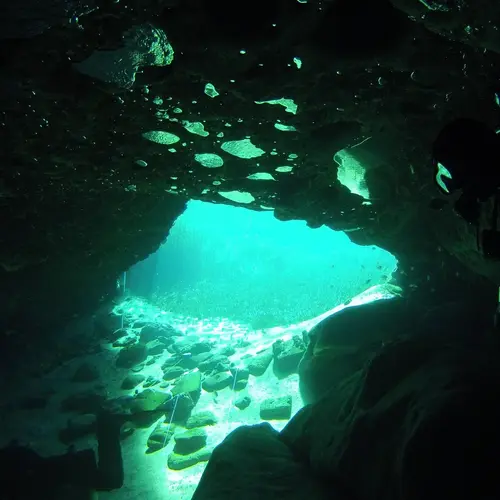Tragic Incident at Jackson Blue Springs: The Untold Story of Diver Benjamin Strelnick Deadly Mistake


| Incident Location | Diver Full Name |
|---|---|
| USA, Florida, Jackson Blue Springs | Benjamin Strelnick |
There is no other feeling than being surrounded by walls underwater with one source of light, feeling the weight of your equipment and oxygen coursing through your body. Cave diving, the sport has been around for years, but even in 2023, there are deadly consequences of entering a cave unprepared. Benjamin Strelnick, or Ben, was diving with a fellow co-worker on May 26th at Jackson Blue Cave in Marina Florida when they decided to follow an established guideline that was tucked away off the main route.
Neither diver had ever entered this section of the cave before, and their curiosity was certainly stronger than their fear. But this one line would change their fate forever and have a lasting impact on the cave diving community. This is their story.
Ben’s Background
Ben Strelnick was 38 years old and described as a warm, open-minded, free-spirited, and adventurous person. He had a special love for outdoor sports, particularly scuba diving, and he was well involved with his communities, even working for DAN (Divers Alert Network) as a medic in North Carolina, where he lived.
He also helped staff a 24/7 hotline for scuba divers around the world, answering inquiries about underwater and dive-related emergencies. Ben was truly cherished by his colleagues and superiors at DAN for his breadth of knowledge, ability to explain complex medical concepts, and superb clinical judgment.

Differences between Cave Diving and Scuba Diving
Regardless of how good of a diver one is, cave diving and scuba diving are completely different. Yes, both activities involve going underwater, and with both activities, a diver can suffer from nitrogen narcosis or being “narced” when you inhale compressed air from an oxygen tank while under a lot of pressure from water. It increases the pressure of oxygen and nitrogen in your body, affecting your central nervous system. Many divers describe being narced as similar to feeling drunk.
Ultimately, though, cave diving and scuba diving each require different skill sets and training to be successful. In cave diving, you are in an enclosed area that may or may not have good visibility. Depending on water flow, it may help clear out visibility, or it may throw your body against the rocks if you run out of strength to fight it.
You can’t just go up, there’s no natural light, and you may have to make life-impacting decisions under very stressful situations to calmly dealing with all aspects of diving simply requires time, effort, and proper training. There are no shortcuts. It’s unclear what exactly led Ben to start cave diving, but he did not become a certified cave diver until 2021.
Another year passed before he received his Sidewinder certification. The Sidewinder is a rebreathing device that was developed in 2016. It provides a balanced, light, small, but reliable device for divers. This device is the smallest rebreather available to the public and is perfect for cave diving. It was this device that Ben would be using on May 26th.
Exploring Jackson Blue Springs
Florida is a hub for divers of all ages to commonly visit and train their skills. The state has a wide variety of caves, ranging from easy to long and dangerous ones. Jackson Blue Springs is a beautiful recreational park where many come to swim or enjoy the sun.

But if you are brave enough to dive down into its depths, you can find a vast cave system that has been explored by beginners and experts. It’s the perfect location for an afternoon dive. On May 26th, Ben and a fellow employee and friend loaded up their gear and set off for the spring. The weather was great, and when they arrived at the park, it seemed like the correct decision to dive that day.
Entering the Cave
It’s uncertain if there were divers directly in front of Ben, but he knew they were not the only ones in the cave that day. The water flow was normal, and the water appeared to be clear in front of them. After performing the necessary checks, they put on their gear, inserted their mouthpieces, and entered the cave.
The Jackson Blue Cave System is pretty straightforward, with a single main passageway to follow. However, there are many small paths that have almost been forgotten about, which are not indicated on the map. Inexperienced divers can sometimes mistake these smaller restrictions as invitations to explore. Many dive experts advise against going into these smaller restrictions as they offer little to see and pose unnecessary risks.
Diving into the Depths
The duo descended to a depth of approximately 79 feet, close to the average depth of the cave. Once they stopped moving and gave each other the thumbs up, they grabbed onto the guideline and ventured further inside. They could see about 80 feet in front of them, with the white limestone rocks standing out on either side. In cave diving, it’s crucial not to stir up the dirt at the bottom, as it can drastically reduce visibility.
The correct way to avoid this is by swimming parallel to the ground and kicking in a controlled, outward fluid motion that stays close to your body. The goal is to avoid touching the walls, floor, or roof with your flippers. Over an hour had passed in the dive when they neared the first T-junction.
The Temptation of a Small Restriction
Just before the first T-junction, there was a small restriction that was hard to spot and not on the map. Ben noticed the smaller restriction as they were passing by but, more importantly, saw a guideline leading down the passageway. Seeing the guideline meant that someone had laid it, suggesting that someone had entered the restriction, found something, and came back out. Intrigued and driven by curiosity, Ben wanted to find out more.
As the more experienced diver, he decided to take charge and be the first one to enter the restriction. They were using a Sidewinder breathing device, which is smaller and more workable in tighter restrictions, adding to their confidence.
Entering the Restriction
Ben slowly approached the opening of the restriction. It was hard to see much inside as it was silted out, but his ambition and desire to explore overwhelmed him. He decided to enter the passage. Inch by inch, propelling himself forward with the help of the guideline, he ventured deeper into the restriction. He was unaware that the cave walls were closing in around him due to the lack of visibility.
Every few seconds, Ben pushed himself forward, repeating the process. He became aware of the cave wall pressing against him only when the pressure became tight. His heart raced as he realized he couldn’t move forward, and there was not enough room to turn around.
A Fatal Decision
Ben found himself wedged tightly in the small opening. Panic started to set in, but he knew that panicking would be a death sentence. He desperately needed to find a solution. His diving partner, unable to see much inside the restriction, realized something was wrong.
Ben appeared to be stuck, and there was no room to maneuver around. Nitrogen narcosis likely influenced their decision-making, impairing their judgment and vision. Ben’s diving partner, with even less experience and no experience on a closed circuit device, attempted to help in some way. However, the details of their attempts and decisions remain unknown.
After some time passed, it became clear that Ben couldn’t free himself. His diving partner made the heart-wrenching decision to leave him and return to the surface to call for help. Although this decision may leave many with survivor’s guilt, it was the correct call. It’s better to have one diver stuck than two. Authorities were notified, and renowned cave diver Ed Sorensen, known for his cave rescues around the world, was called in. Unfortunately, when they reached Ben, it was too late. He had already passed away.
Investigation and Debates
The investigation revealed that one of Ben’s tanks still had a significant amount of air left, leading to theories about his cause of death. One theory suggests that he couldn’t maneuver enough to reach the tank and utilize it.
However, the more likely scenario is that panic overwhelmed him, leading to drowning. Regardless of how it happened, one thing is clear: Ben and his diving partner didn’t have enough Sidewinder training to enter such a tight restriction, nor did they have the experience to handle the situation when their judgment and visibility were impaired.
This story has sparked a timeless debate in the cave diving community. The guideline Ben followed was part of a side passage not on the main map, yet close to the cave entrance. Most divers are reluctant to remove the line. However, having lines so close to the entrance can lead inexperienced divers to follow them without being aware of the dangers.
While it’s important to educate divers and discourage overconfidence and following unknown lines, Jackson Blue will always attract beginners exploring its depths. Blue springs diving deaths serves as a reminder of the perils of overconfidence and eagerness for all.
Conclusion
In conclusion, I want to end this story with a quote from Ben’s mother: “Ben knew the risk involved in scuba diving and would tell his mother, ‘If I died diving, at least know that I died happy.'” While his words bring some comfort, it serves as a reminder of the inherent risks associated with diving and the importance of proper training, judgment, and respect for the dangers that lie beneath the surface.
FAQ
Jackson Blue Springs offers crystal clear water, underwater caves, and diverse aquatic life, including fish and turtles.
Jackson Blue Springs is located in Jackson County, Florida, USA.
No, diving in the underwater caves at Jackson Blue Springs is restricted to trained and certified cave divers due to the complex and potentially dangerous nature of cave diving.
Yes, swimming is allowed in the designated swimming areas at Jackson Blue Springs. It is a popular spot for recreational swimming and snorkeling.
Yes, Jackson Blue Springs has facilities such as picnic areas, restrooms, and a concession stand. It provides a comfortable environment for visitors to enjoy their day at the springs.
